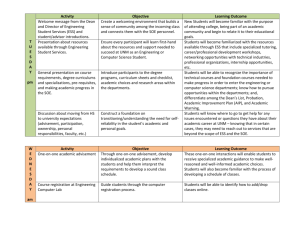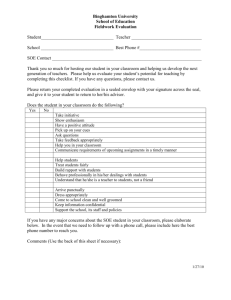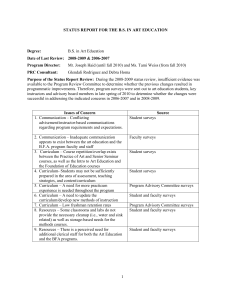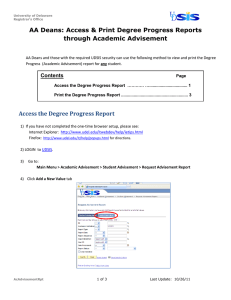Status Report Review Planning and Review Committee 2010-11 Degree: Program Director:
advertisement
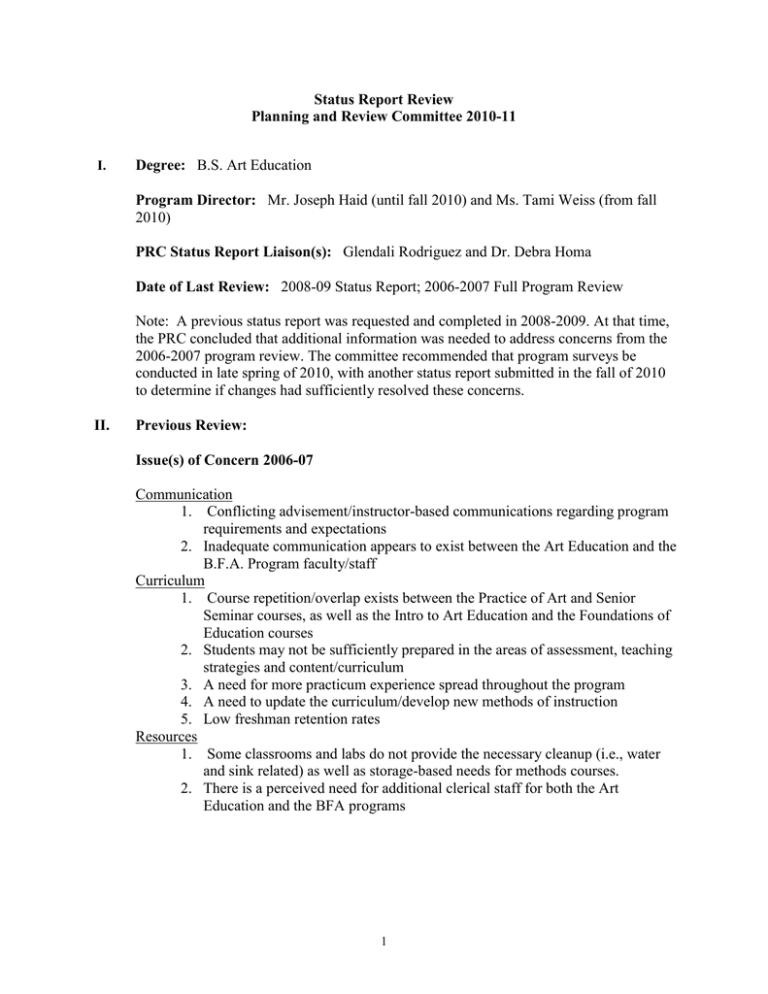
Status Report Review Planning and Review Committee 2010-11 I. Degree: B.S. Art Education Program Director: Mr. Joseph Haid (until fall 2010) and Ms. Tami Weiss (from fall 2010) PRC Status Report Liaison(s): Glendali Rodriguez and Dr. Debra Homa Date of Last Review: 2008-09 Status Report; 2006-2007 Full Program Review Note: A previous status report was requested and completed in 2008-2009. At that time, the PRC concluded that additional information was needed to address concerns from the 2006-2007 program review. The committee recommended that program surveys be conducted in late spring of 2010, with another status report submitted in the fall of 2010 to determine if changes had sufficiently resolved these concerns. II. Previous Review: Issue(s) of Concern 2006-07 Communication 1. Conflicting advisement/instructor-based communications regarding program requirements and expectations 2. Inadequate communication appears to exist between the Art Education and the B.F.A. Program faculty/staff Curriculum 1. Course repetition/overlap exists between the Practice of Art and Senior Seminar courses, as well as the Intro to Art Education and the Foundations of Education courses 2. Students may not be sufficiently prepared in the areas of assessment, teaching strategies and content/curriculum 3. A need for more practicum experience spread throughout the program 4. A need to update the curriculum/develop new methods of instruction 5. Low freshman retention rates Resources 1. Some classrooms and labs do not provide the necessary cleanup (i.e., water and sink related) as well as storage-based needs for methods courses. 2. There is a perceived need for additional clerical staff for both the Art Education and the BFA programs 1 Consultant Response- Summary Status Report 2010 Resources 1. As noted in the Status Report Review of 2008-2009, a main classroom used in art education (HE 103) was completely remodeled in January 2009. This included new and appropriate cabinets, sinks, chairs and tables, storage cabinets on wheels and demonstration carts. In addition, a SmartBoard was added to this classroom in spring of 2010. The spring 2010 student surveys suggest that this is not an ongoing concern. 2. The Art Education Program Director was relocated to McCalmont Hall in January 2009 to make more clerical support available to the Program Director and students. The program now has access to a support person who helps organize materials, schedule advisement meetings, and communicate program information to students. The spring 2010 status report suggests that this is not an ongoing concern. Curriculum 1. The spring 2010 student surveys suggest that progress has been made in addressing course repetition/overlap, as students do not indicate concerns about course overlap between the Practice of Art and Senior Seminar courses or between Introduction to Art Education and Foundations of Education courses. However, responses from the recent student surveys indicate that students believe there is unnecessary overlap/repetition among all of the Art Education courses (108, 208, and 308). The Program Director and SOE Director will develop a new curriculum plan that ensures an appropriate sequence for these three courses. Once the new curriculum plan is completed, the Program Director and SOE Director can determine if a revised curriculum and program plan are needed. 2. The program has taken a number of efforts to ensure that students are sufficiently prepared in the areas of assessment, teaching strategies, and content/curriculum. The previous Program Director attended professional development conferences to enhance skills in these areas, and a consultant was hired to work with the Program Director in the summer of 2009 to assist with course development and program revision with a focus on assessment, teaching strategies, and content/curriculum. However, the spring 2010 student surveys continued to indicate that students see a need for more emphasis in these areas. In the fall of 2010, a new Program Director was hired who has current experience as an art teacher. Although the new Program Director has been including more curriculum content related to these areas of concern, it is too soon to determine if this issue has been sufficiently resolved. 3. The spring 2010 student evaluations suggest that the concern regarding a need for more practicum experiences has been addressed. 4. The recent student survey results indicate that students continue to see a need for updated curriculum and new methods of instruction. The SOE Director, Program Director, and Chair of the Art and Design Department plan to submit a revised Art Education program to the SOE, CEHHS, and Curriculum Review Committee in the fall of 2011. 5. The Program Director has taken a number of steps to improve student advisement and retention in the program. An SOE Student Ambassador from the program is now included in the SOE Student Ambassador Team, which acts as an advisory group for 2 the SOE Director. The Program Director has initiated additional approaches in the 108 class and Advisement Day to encourage retention; for example, a mentoring system in which upper-level art education students help mentor freshmen in the program, and inviting guest speakers to present to the students. This fall, the Program Director has also met with each currently enrolled student and documented each meeting. Upper-level students have also been supporting and guiding freshmen through involvement of the National Art Education Association student division. In addition, enrollment has increased since the PRC review of 2006, and enrollment reportedly has been strong in the last few years. Communication 1. 2010 student survey responses did not echo previously identified conflicting advisement/instructor-based communications regarding program requirements and expectations. However, 2010 responses reflected that students were receiving unclear and inaccurate information about program requirements and how to plan out their programs of study to facilitate satisfactory and timely program completion. Since August of 2010, the new Program Director has: consulted with the SOE Director and the Chair of the Art and Design department on a frequent and regular basis; created a new advisement form, signed by both the PD and student, in which the Program Director documents the student’s questions and issues and a specific plan to address the issues and questions; sent frequent emails addressing follow-up concerns, Benchmark information, PPST and PRAXIS II information, advisement schedules, ePortfolios, and Mid-Program Review information; created a D2L “news page” with a pretest students can take to determine if they are acquainted with key program information; facilitated a group advisement meeting on Advisement Day in fall of 2010 between students and the new Program Director and the student teaching supervisor. 2. 2010 survey responses did not strongly echo previously identified inadequate communication between the Art Education and the B.F.A. Program faculty/staff. Several steps were taken to improve inadequate communication between the art education and the B.F.A. program faculty and staff as identified in 2008-2009. These include: collaboration with the Chair of the Art and Design department, on the development of the Department of Public Instruction Program Report, in anticipation of the DPI accreditation review; invitation of the B.F.A. program staff to participate on the Art Education Program Advisory Committee and the Program Director of the B.S. in Art Education program to Art and Design department meetings; and participation by the Chair of the Art and Design department in a few Benchmark interviews of students in the B.S. in Art Education program. However, a few comments from the spring 2010 student surveys indicate a continued need for rapport and collaboration between the art education faculty and the studio art faculty. Since August of 2010, the new Program Director and the Chair of the Art and Design program have met regularly for face to face meetings and phone conversations regarding student advisement. Also, course syllabi for courses required in the art education program were discussed, specifically addressing Department of Public 3 Instruction (DPI) requirements. Furthermore, the Chair and Program Director discussed the specific requirements of the Mid-Program Review for art education students, and the Program Director will take part in the review itself, along with the studio art faculty. Also, the Chair and Program Director communicated regarding program-required courses offered in the Winterm and the development of a double major program plan. III. Committee Findings: The committee commends the program director, and the SOE Director in addressing many of the concerns raised in the 2006-2007 program review and 2008-2009 status report. The committee also commends the current program director on the communication efforts made with students and collaboration efforts with the Department of Art and Design. However, results of the 2010 surveys indicate that several issues of concern remain unresolved. Although the SOE Director and new Program Director have taken strong and positive steps to address these issues, some of these were initiated in fall 2010, after the spring 2010 student surveys. In addition, the committee recognizes that the sustainability of the program director position is also a concern. The committee therefore recommends that program surveys for students, key instructors and advisory board members be conducted again in the fall of 2011 and another status report be submitted in the spring of 2012 to determine whether the recently made changes have successfully addressed the indicated concerns. 4
